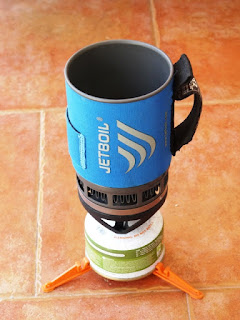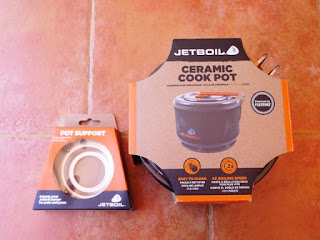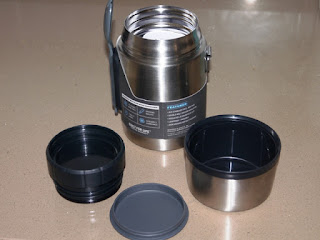Preface:
I do love my spirit stove, there's no denying that. But I recently got to thinking that I would be better running it on gas, not so much from an efficiency point of view but from a safety aspect - even when the fire bans aren't in place here everything it still pretty dry, and one overzealous movement could result in burning fuel pouring over dry pine needles and the like. I'm definitely a "better safe than sorry" kind of guy.
Anyway, if you've read the review of my spirit stove (see here) you'll know it's a sort of Trangia / Optimus clone that takes a Trangia burner and so any Trangia-compatible gas burner should fit. However, they're few and far between; the choices seem to be limited to the genuine Trangia version, the Robens Fire Tick (which may or may not be discontinued - it's certainly out of stock everywhere I looked) or any number of no-name variants on Aliexpress.
With neither the patience to wait for the Robens to come back in stock nor the justification for spending 50% more again on the Trangia version, I started to look at other options......
Review:
When I reviewed my Alpkit BruKit some years ago I mentioned that I had been prompted into buying it after my Jetboil Zip never arrived. Well, having decided that the BruKit wasn't best-suited to my needs, I sold it on to Bob, and eventually bought the Jetboil. It's had more use than I ever thought it would - and not just for camping. It's my go-to water boiler when we have a power cut and it came in our hand luggage when we emigrated and was our main cooking source until we I put the new kitchen in.
As with the BruKit, cooking isn't its forte, but we managed. These kind of stoves are designed primarily for rapid water boiling, and at that they excel, but the pot height and diameter makes cooking with it a bit more challenging. Unlike the larger BruKit, the Zip's compact 0.8l pot also rules out boil-in-the-bag cooking. So in the main the Jetboil has been used for making a brew (and has accompanied me on many a day out) or boiling up water for instant noodles.
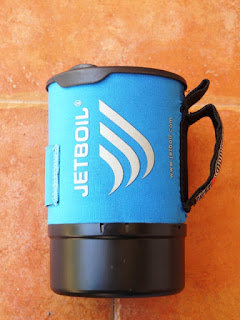 |
| The burner, gas and stabiliser pack into the pot, while the cup sits underneath |
Until now, that is, when I discovered that Jetboil make a pot support to take pretty much any stand-alone pot or pan. Again, sourcing one was a challenge. I think I managed to find about the only place in Spain that still had stock, and promptly ordered one up along with the matching Jetboil 1.5l cooking pot.
The Jetboil Zip is the most compact of the Jetboil stoves, with it's 0.8l capacity pot. Out-of-the-box it comes with the burner, pot with neoprene sleeve, stabiliser support, lid and bottom cover. The cover doubles as a bowl/cup and the lid has both a pouring spout (which can also be used to drink from) and strainer holes. The burner, stabiliser and gas (100g) pack away neatly inside the pot for transport/storage. It runs on any EN417 butane/propane gas cartridge, but while the stabiliser will accept 100g and 230g cartridges only the former can be packed away into the pot. There is no piezo ignition on this model, so it has to be lit with a match/cigarette lighter.
The Jetboil boils water fast. There may be faster stoves out there, but at 2 minutes 30 seconds for half a litre it's no slow coach. As I tend to only boil a mugs-worth at a time, it comes in even quicker. This is thanks in part to the built-in heat exchanger, or FluxRing as Jetboil call it - a feature present throughout Jetboil's range. A coffee-press attachment is also available to turn the Zip into a cafetiere.
The optional pot stand locks securely to the burner in place of the standard pot, and allows use of the Jetboil cookpot, frying pan or other third-party pots (Jetboil say not to use pots with a diameter greater than 23cm or a capacity greater than 2l).
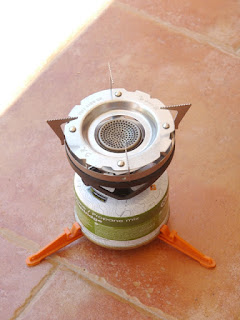 |
| The Zip burner with pot stand fitted |
While the Jetboil Zip is a great piece of kit, the cook pot is a massive disappointment. For a start off, the price is extortionate for what it is, even if it was designed and built well - which it isn't. The lid is ill-fitting with a good 5mm of lateral play, and though one can only assume this is by design, I've no idea why - it isn't to let steam escape, because the lid has strainer holes in it.
The handle, while serviceable, is underwhelming for a product at this price point (I've seen far better designs on products costing a quarter of the price), and it's also in the wrong place - it sits below the half-way mark then angles back upwards, which serves to make the pot top-heavy when handling and downright awkward to hold when eating directly from the pot. On top of that, it isn't even fitted straight - the bracket is riveted to the pot off-centre, and the bracket itself isn't square either, so the whole handle is on a twist.
Though obviously intended to be used with the pan support, it's no more secure in place than any other pot. It does have a slight lip around the bottom to (in theory) prevent it sliding off the stand, but this has rounded edges and is so shallow that it doesn't actually achieve anything (one of the reasons I opted for the Jetboil pot over a third-party one was that I assumed it would be designed for purpose and thus a better and more secure fit). I certainly wasn't comfortable stirring my food without keeping a firm grip on the handle.
If I was to sum it up, it has the feel of an existing OEM product that has had the Jetboil name slapped on it rather than something that was designed from scratch to integrate with the Jetboil system.
At 1.5l, the Jetboil cook pot is way too big for a single person and more than ample for two (in fact you can probably fit the contents of five packets of Wayfayrer food in it) - 1.2l to 1.3l is plenty big enough for two people, so this pot is better suited to group cooking. The latest version features a non-stick ceramic coating, which while nice in principle does mean extra care has to be taken when packing the gas, burner, etc into it to avoid scratching the coating. Basically you're going to have to find a suitable bag to put them in first. This also limits you to using plastic utensils for the same reason.
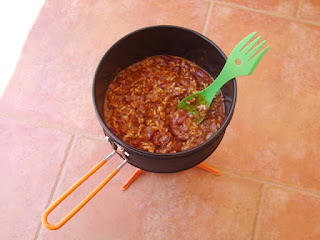 |
| A 400g can of chilli and 125g pre-cooked rice just disappear in the 1.5l pot |
On the plus side, the included pot lid is transparent so you can keep an eye on your food without having to lift the lid and let heat escape, which is a nice touch though hardly a unique feature. The non-stick coating does its job, and food does heat up/cook very fast. My obligatory chilli con carne was cooked in a matter of minutes. I have yet to test a conventional third-party pot to see how much difference the FluxRing makes, but Jetboil claim 2x faster boil times and from my experience of using the Zip pot I'm inclined to agree.
If you were setting out to buy a Jetboil for cooking on, the better option in my opinion would be the MiniMo; its 1l pot is more suitable for single-person use and less bulky, as a system it weighs less than the Zip burner & 1.5l pot combination, and it works out roughly the same price. It's also worth mentioning that pretty much every Jetboil component is available as a spare part, so if you particularly wanted this set up the cheapest option would be to buy the Zip burner, stabiliser, pot stand and 1.5l pot individually.
As it is, I now have a flexible system that can cover a multitude of options, from day-trip coffee making to two-to-four-person camp cooking - though it's unlikely I'd take the pot on solo trips due to its size.
In conclusion, the Zip is an outstanding bit of kit (even more so with the added flexibility that the pot support provides) and an almost must-have, while conversely I honestly wouldn't recommend the pot at all on the basis that the design and quality is poor (especially for the price) and there is no shortage of alternatives.
NOTE: I sent Jetboil a link to this review as I was interested to hear their thoughts on my observations and comments regarding the cook pot, and did eventually have a conversation with them, but ultimately their customer service turned out to be as good as the pot I was complaining about.



